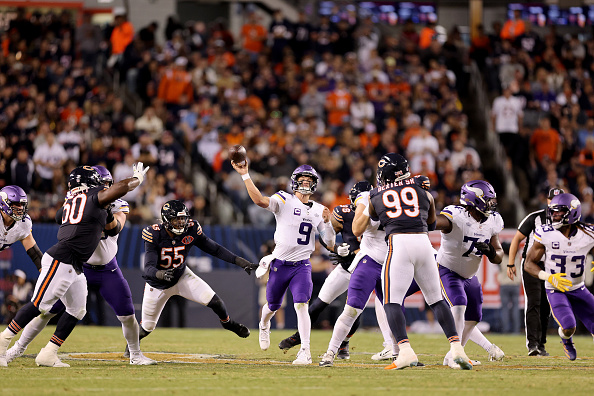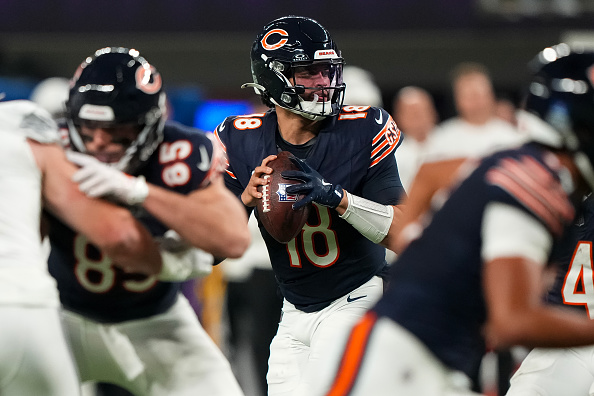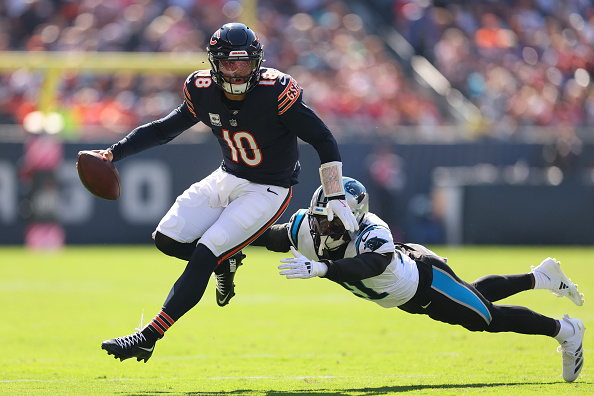When the Chicago Bears traded for All-World superstar edge rusher Khalil Mack, the team’s expectations rose from “rebuilding project” to “playoff contender.”
The latter high hopes were undoubtedly an understatement, as the historic franchise ran away with the NFC North crown a season ago. After going 12-4 and being a doink or two away from the divisional round, Bears fans are understandably as excited as ever for the upcoming season.
Given the hopes for a continued growth of quarterback Mitchell Trubisky under head coach Matt Nagy, paired with the common assumption that the defense is going to repeat it’s destructive performance, it’s easy to see why the Windy City has its mind set on the Lombardi Trophy. That assumption, though, is one that should require a little more caution than it’s been given.
As much as Khalil Mack stole the show destroying opposing offensive tackles, the true strength of the defense came from the secondary, where the group posted one of the best seasons from a coverage standpoint. When you look throughout the recent history of great defenses, a common finding is a fantastic coverage unit. In fact, a lot of modern football analytics will say that a great coverage unit is more valuable than a great pass rush, and the Bears may have exemplified that notion as much as ever.
This sounds all great and dandy, except for one large glooming issue: a team’s coverage ability from year-to-year is relatively volatile, and has a strong tendency to fluctuate. This was proven no further back than this past seasons’ Jacksonville Jaguars. In 2017, Jalen Ramsey and Co. led the Jags to an AFC Championship appearance, and the defense was generally viewed as the league’s best. This, of course, caused a lot of people to mistakenly invest in a team led by Blake Bortles as Super Bowl contenders. Everyone can learn a lesson from these defensive trends. Just as we saw Jalen Ramsey and AJ Bouye play noticeably less outstanding, that’s something fans need to acknowledge when evaluating the Chicago Bears heading into 2019.
Before I get into next season’s outlook, let’s take a look back at what made the Bears such an incredible defensive unit this past year, position by position.
Safety
If you thought the pass rush was impressive, prepared to be blown away. The pure dominance that the Chicago secondary demonstrated last season deserves so much more national spotlight than it’s been credited for, and it started at safety a year ago.
Led by the best safety duo in the league, the Bears’ ability to keep receivers on lockdown should be credited most to their success. Eddie Jackson, the best safety in the NFL this past year, was the playmaking menace that kept the train rolling all year. The second year ballhawk out of Alabama blew expectations out of the water, leading the league in combined pass breakups and interceptions with 14. It was clearly a career year for the turnover and touchdown machine, and if he can even come close to matching this season from a coverage standpoint, the Bears will be just fine at free safety.
Extremely reliable but understandably forgotten about, Adrian Amos has been a model of consistency over the past two seasons for Chicago. It’s tough to make a big name for yourself when you’re surrounded by superstar ballhawking talent, but Amos’s value as an uber-dependable and versatile safety can’t go unnoticed any longer. He doesn’t garner much of the spotlight due to his lack of “big plays,” but he avoids making bad plays as well as anyone else at his position, and just not ever screwing-up is immensely valuable from the safety position. They often say durability is the best ability and Amos is the epitome of that, leading Chicago’s defense in snaps played a year ago. His departure in free agency is an extremely underrated move for Green Bay, and it’ll be interesting to see how Chicago fills the void left by one of its best players.
Cornerback
If the dominance at safety wasn’t enough, it keeps getting better for the Bears’ secondary. Chicago’s three primary starting cornerbacks each had arguably the best season of their careers, led mostly by superstar Kyle Fuller. As one of the league’s premier cornerbacks over the past few seasons, Fuller’s value on the outside is dismissed far too much. He’s arguably the best playmaker at his position, leading the NFL in forced incompletions over the past two seasons with 42. The Virginia Tech product allowed a passer rating of only 66.6 into his coverage, acting as a devil towards opposing receivers.
But what’s better than a great cornerback? Two great cornerbacks.
Prince Amukamara joins Fuller with his best campaign to date, giving up an even more impressive 59.6 passer rating his way. Amukamara excelled in zone coverage last season as the perfect Robin to Fuller’s Batman.
Having three great cornerbacks is even better than having two, but Bryce Callahan is headed to Denver and there’s a large void in the slot to be filled. Chicago struck gold with the undrafted free agent in 2015, and even Callahan had his most impressive season up to this point. As almost entirely a slot cornerback, the Rice product was second in the NFL in yards allowed per cover snap from the slot with 0.69 (PFF). With the rising importance of the slot defender, Callahan was one of the unsung heroes of the Bears’ defensive unit.
Defensive Interior
After two quiet but productive seasons in Chicago, Akiem Hicks finally broke into the national spotlight in 2018. The clear leader for the Bears’ run defense, Hicks’ 48 run stops (tackles that result in a win for the defense) were good enough for second among interior defenders behind only Damon Harrison (PFF). The star defensive tackle was one of the league’s most valuable at his position in his most recent campaign and he’s solidified himself as a top 10 defensive tackle.
Not to be forgotten along the line was 2015 second-round selection Eddie Goldman, who blossomed into a more versatile defensive tackle in his fourth year. Before the 2018 season, many would’ve considered Goldman to be a nose tackle only. He surely bucked that trend with a huge improvement at the more impactful three-tech position across the defensive line, which made him a lot more valuable to his team. The on-the-rise big man was one of the team’s unnoticed key pieces.
Edge Rusher
It would be a mistake not to talk about the impact Khalil Mack created when he was brought in from Oakland. From the very time he stepped on the field Week 1 against Green Bay, Mack took the league by storm with one of the most dominant defensive performances of the entire 2018 season. You can debate whether or not general manager Ryan Pace gave up too much of his future for Mack, but there’s no debating how good of a player he received.
Since Mack was drafted fifth overall in 2014, he’s been the best edge rusher in the entire league. According to PFF, Mack has accumulated four or more quarterback pressures in 56.3 percent of games in his career, a figure that’s more than 10 percent higher than any other player at the position in that time span. It’s a number that highlights how consistently he’s able to get after the quarterback at a very high rate, but we probably didn’t even get to see Mack’s true best in 2018.
While dealing with some nagging injuries throughout the year, the First Team All-Pro recorded his lowest pass rush win rate since his rookie season. This is no reason to suspect a decline is occurring, but rather that the injury held him back from truly unleashing his best work. As crazy as it is to say, Mack may be even better next year.
The antithesis to the new king of Chicago may have been his edge running-mate Leonard Floyd. The former top 10 pick out of Georgia came into the Windy City a little raw, but with huge upside potential. To say he’s been a disappointment is an understatement. While slowly improving his craft as a run defender, he hasn’t really shown anything when it comes to getting after the quarterback. It’s a cause for concern for the team, especially if injuries continue to derail Mack opposite of Floyd.
Linebacker
There were lofty expectations for the linebacking corps of the Bears, and the group ended up a little more ‘bleh’ than many had hoped to see. Danny Trevathan is the trusty veteran manning the middle of the defense, but he ended up quite vulnerable in coverage in 2018. Although remaining the teams’ most surefire tackler, Trevathan allowed a passer rating of 114.1 on throws into his coverage. That was good enough for 68th among qualifying off-ball linebackers, according to PFF. He was able to improve his impact as a blitzing backer, racking up a career high 22 quarterback pressures, but given the growth of value of the coverage linebacker, Chicago probably wants to see more from the former Bronco as he works with first-round pick Roquan Smith.
Speaking of the former eighth overall pick, eyes are fixated on Smith, the first-round linebacker who was a little slow coming out of the gate a year ago. His public contract holdout may have had an impact, but Smith was visibly struggling against the run throughout most of the season. He has all the ability to become a Pro Bowl-caliber linebacker, but he needs to show more well-roundedness to his game before he gets there. Thankfully for Bears fans, he was able to make up for some of Trevathan’s shortcomings in coverage. While ranking 13th among linebackers in passer rating allowed, he showed off his strengths roaming the middle of the field, the main reason for his top 10 selection last April.
A Statistical Overview
Simply put, the Bears unquestionably sported the best defense in the league in 2018. Chicago’s complete dominance at every level left little to be desired and was the primary reason for returning the NFC North to the Windy City.
Khalil Mack and company’s destruction up front allowed the Bears to play the least amount of plays with a heavy box with 101, which was mind-blowingly 65 less than the next fewest. This allowed the team to focus more on the coverage unit which was all the more impressive.
There’s more shocking stats where that came from.
Just to highlight how good the coverage unit was even without the help of pass rush, when opposing quarterbacks weren’t pressured, Chicago allowed the second fewest explosive plays (20+ yards) and third fewest yards per attempt.
Even with offensive coordinators bringing out all the best for this loaded defense, they couldn’t scheme against it. The Bears allowed the second fewest yards per RPO, fourth fewest yards per play-action, and fourth fewest yards per screen play in the entire league (PFF). Statistical dominance like this doesn’t come around too often, so it’s fair to reminisce on how phenomenal this unit really was.
What to Expect in 2019
I currently own a ticket for the Bears’ under 9.5 wins for this coming season, which seems to be against what most of the public believes. All of this defensive firepower has left most Chicagoans with high hopes for the coming season, but I’m here to highlight why this fantastic play is an imminent sign of regression.
After boasting about how special all five of the Bears primary secondary members were in 2018, coverage ability has a strong tendency to fluctuate and it’s extremely difficult for players to maintain that type of production over the course of multiple seasons. Having three of the league’s 15 best cornerbacks and two of the five best safeties is extremely unlikely to happen again, or being even relatively close to that level. Just think about the realistic chances that almost your entire secondary has the best season of their careers two years in a row. The stars aligning like that in 2018 was phenomenal and shocking in its own right, but it’s outlandish to expect them to play at that high of a level again in 2019.
To add insult to injury, two of those five players just happened to pack their bags in free agency. The bigger concern of the two is almost certainly the loss of Bryce Callahan, where the value that a slot defender carries is a lot larger than most come to realize.
Buster Skrine was signed from the New York Jets in an attempt to fill that void, but the discrepancy between the two cannot be stressed enough. While Callahan ranked second in yards per cover snap allowed from the slot last season, Skrine came in at 37th. Callahan placed seventh in passer rating allowed on slot targets last season; Skrine was still 37th. The ninth-year man also happened to allow the most touchdowns from the slot last season, which is not great at all. This is a drop-off that not enough people are talking about, and this could be the team’s Achilles heel in 2019.
Replacing Amos is less of a daunting task considering the acquisition of HaHa Clinton-Dix from Green Bay. Clinton-Dix was a reliable deep safety for the green and yellow over his career, but he has yet to put up the consistent elite level play everyone has enjoyed from Amos.
The 2018 Bears did a lot of things that simply aren’t replicable from one year to the next. Most notably, the team converted quarterbacks’ turnover-worthy throws into interceptions at an alarmingly high rate. It’s tough to find the exact number, but this statistic is an unstable one that is extremely unlikely to do anything other than regress to the mean. It was really just one of those defensive years where everything goes your way.
Often lost in the mess of an offseason full of players moving teams, coaching matters. Denver’s new head coach and former Bears defensive coordinator Vic Fangio did an outstanding job scheming around opposing offenses. It’s impossible to tell whether or not Chuck Pagano can have the same successes Fangio enjoyed, but we do know the team is losing a great defensive mind.
Tons of football people and sportswriters are listing the Bears as their favorite to play in the Super Bowl, mostly because of the highly touted defensive squad. I have my reservations about the team moving forward, simply because of how likely defensive regression is with this team; I don’t think people truly understand yet how tough it is to replicate what an all-time great defense can do two years in a row.
The schedule Chicago is slated to go against is much tougher than it was last year, and more specifically the offenses it has to go through. The Bears now play a first place NFC schedule, rather than a last place one, as well as going up against the AFC West (hello Mahomes, hello Rivers). Not to mention Aaron Rodgers is back and healthy twice a year. All put together, it’s too improbable for Chicago to be the same team from a year ago.
Great defenses in today’s pass-happy league almost always sport a fantastic secondary, but the inevitable regression may leave some Bears fans in shock in the coming season. We can surely expect Khalil Mack and Akiem Hicks to continue their destruction of offensive lines, but barring a strong improvement from Mitchell Trubisky, it’s tough to imagine Chicago not being worse in 2019.






